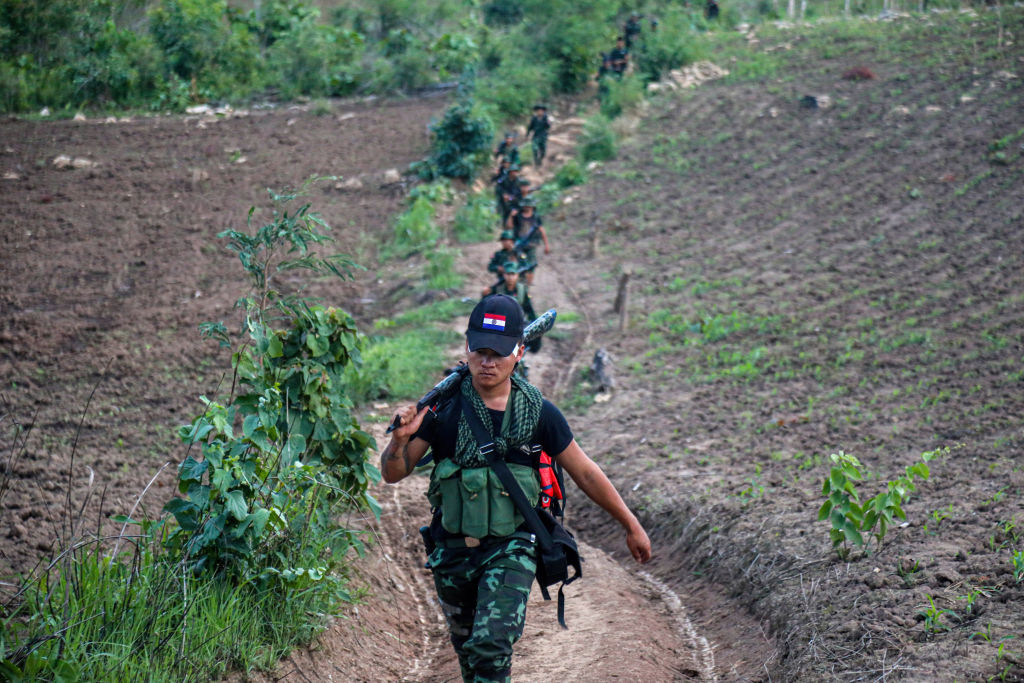
Myanmar moves from military coup to a civil war that is now a revolution. The junta’s bungled effort to turn the clock back by seizing power in February 2021 has been a bloody fiasco.
The regime ‘controls’ less than half of Myanmar: it’s ‘too unpopular to control the countryside, yet too powerful to yield the cities’. And much of that ‘control’ is contested.
Unable to impose its will, the junta is mired in failure—in its operations, its understanding and its standing.
Calling it a ‘junta’ may be too kind, suggesting military competence and political dominance. Perhaps ‘mafia regime’ is closer.
Myanmar’s wicked tragedy has completed the military’s journey from revered institution to reviled enemy. The extent of the regime’s failure on so many fronts is one of the few firm facts amid the fog of Myanmar’s war.
While it still has the strongest military force (equipment, firepower and control of the air), the junta is fighting ‘on an unprecedented number of fronts’. The International Institute for Strategic Studies reports that the conflict rages in seven theatres which can be grouped into three categories:
- borderland resistance strongholds (southeast Myanmar, Kachin State and northwest Myanmar)
- central contested areas (the Dry Zone and lower Myanmar)
- non-aligned areas (Shan and Rakhine states).
The conflict has blown away the old coup script (roll tanks, imprison politicians, enjoy power). Instead, the coup grasped government but not the country, sparking a war that proclaims revolutionary change.
The shift ‘from coup to revolution’ was the title and theme of the annual Myanmar Update, a two-day conference at the Australian National University: ‘The military’s violent crackdown on what was initially a peaceful popular uprising provoked a near-countrywide revolutionary movement, which has brought together an array of different political, ethnic, and religious groups fighting for the shared goal of ending military rule.’
Chairing the politics session, an eminence of Australia’s study of Myanmar, Andrew Selth, quoted one of literature’s greatest opening lines: ‘It was the best of times, it was the worst of times, it was the age of wisdom, it was the age of foolishness, it was the epoch of belief, it was the epoch of incredulity, it was the season of Light, it was the season of Darkness, it was the spring of hope, it was the winter of despair …’
As Selth noted, Charles Dickens’s writing about the French revolution describes much about Myanmar’s revolution.
My version of the big questions that confront Myanmar involves opposed scenarios: Will the revolt overthrow the military regime and remake the nation? Or will Myanmar fly apart, fragmenting along the fault lines of all those conflicts?
The government-in-exile, the National Unity Government (NUG), offers a vision of federation, not fragmentation. The NUG’s foreign minister, Daw Zin Mar Aung, told the conference that the military can no longer win with its old divide-and-rule tactics: ‘This is no longer about the coup. It’s not about the military.’ She said the military was losing to the NUG’s vision of federalism, to move closer to the people and ‘undo the wrongs of the past’.
The NUG’s representative to Australia, Tun Aug Shwe, told the conference that protests against the military in previous decades had aimed for dialogue and negotiation, release of political prisoners and parliamentary elections. Today, the revolution has two demands: ‘Eliminate the military leadership from Myanmar soil forever. Second, build the genuine federal democracy in Myanmar. Very focused. So previous revolution focused on the process level. But today people focus on the outcome, the end result.’
Myanmar’s military is smaller than commonly thought, according to an analysis by Ye Myo Hein, a global fellow at the Wilson Center. Dismissing estimates of a military headcount of 300,000 to 400,000, his alternative estimate of 150,000 personnel is ‘based on extensive interviews with military deserters and defectors, analysis of internal military directives and meeting notes, historical records of troop movements and sizes, and casualty counts from primary conflict data and military hospital records’.
Ye Myo Hein concludes that of those 150,000 personnel, ‘roughly 70,000 are combat soldiers. At least 21,000 service members have been lost through casualties, desertion and defection since the coup. At this troop level, the Sit-Tat [military] is barely able to sustain itself as a fighting force, much less a government.’
Ye Mo Hein told the conference that the military can’t crush the resistance so it’s preparing for an ‘enduring and protracted war’ by seeking to tighten control over urban areas and strategic routes, launch frequent forays into resistance areas, and ‘divide and conquer’. He says that if neither side can achieve a ‘decisive victory’, Myanmar could shatter into a series of warring states: ‘If the regime remains in power, the conflict will drag and Myanmar could face a political black hole, potentially leading to balkanisation. While no signs of balkanisation are visible yet, the possibility cannot be ruled out if the conflict persists and political agreement remains elusive.’
The military has ceded ground and legitimacy. The regime has proved it can’t win. What’s yet to be established is if it can lose.
Myanmar’s revolution has changed much. But it faces the opposed futures that Dickens identified in another era: ‘[W]e had everything before us, we had nothing before us, we were all going direct to Heaven, we were all going direct the other way.’

